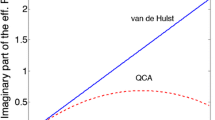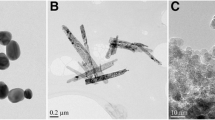Abstract
Optimal TiO2 opacity is achieved when the TiO2 particles are well spaced. Nanoparticle extenders are claimed to improve TiO2 spacing by positioning themselves between the larger TiO2 particles (0.25 μm) and preventing the TiO2 particles from approaching or touching one another. Claims have been made that this can as much as double the light-scattering efficiency of TiO2. This concept was tested by a combination of Monte Carlo simulations and image analysis techniques to determine computationally how the effectiveness of this approach is affected by TiO2 concentration, nanoparticle concentration, and nanoparticle size. Surprisingly, the results showed that nanoparticles did not, in fact, improve the spacing of TiO2 particles under any of the conditions examined (specifically, in the absence of any inter-particle interactions). Instead, TiO2 distributions and spacings were completely indifferent to the presence of smaller particles (however, large extender particles were found to cause TiO2 crowding, consistent with expectations and experiments). Explanation and implications of these findings are discussed.









Similar content being viewed by others
Notes
The reader is cautioned that terminology of this phenomenon in the literature is somewhat confounding. In the early literature, this mechanism was termed “TiO2 spacing,”21 but this term was later changed to “TiO2 dilution”.11 This change was made because the original term was somewhat misleading, suggesting that extender particles push two nearby TiO2 particles apart and increase their separation distance.13 , 16 The term “TiO2 spacing” is now, in fact, used to describe this latter effect. The literature is further confused by one author’s unfortunate use of the term “TiO2 dilution” to describe the partial replacement of TiO2 pigment by small extender particles,24 rather than the replacement of large extender particles by small extender particles.
Extender particles of intermediate size offer some light scattering advantages over large size extender particles, but still cause the pigment particles to crowd more than if the extender volume was instead occupied by resin. This can be accounted for in the Effective PVC calculation by including a variable termed “dilution efficiency” that modifies the magnitude of the contribution of extender volume to the PVC calculation.15
References
Bruehlman, J, Thomas, LW, Gonick, E, “Effect of Particle Size and Pigment Volume Concentration on Hiding Power of Titanium Dioxide.” Off. Dig., 33 (433) 252–267 (1961)
Tunstall, DF, Hird, HJ, “Effect of Particle Crowding on Scattering Power of TiO2 Pigments.” J. Paint Technol., 46 (588) 33–40 (1974)
Auger, J-C, Martinez, VA, Stout, B, “Theoretical Study of the Scattering Efficiency of Rutile Titanium Dioxide Pigments as a Function of Their Spatial Dispersion.” J. Coat. Technol. Res., 6 (1) 89–97 (2009)
Fitzwater, S, Hook, JW, III, “Dependent Scattering Theory: A New Approach to Predicting Scattering in Paints.” J. Coat. Technol., 46 (588) 33–47 (1974)
Blackinton, RJ, “Some Optical Problems of the Paint, Varnish and Lacquer Industry.” Engineering and Science, 8 (5) 10–14 (1945)
Dietz, PF, “Spacing for Better Effects.” Eur. Coat. J., 7–8 14–19 (2003)
Yamada, S, Mouri, E, Yoshinaga, K, “Incorporation of Titanium Dioxide Particles into Polymer Matrix Using Block Copolymer Micelles for Fabrication of High Refractive and Transparent Organic–Inorganic Hybrid Materials.” J. Polym. Sci. Part A: Polym. Chem., 49 (3) 712–718 (2011)
Aspnes, DE, “Local-Field Effect and Effective-Medium Theory: A Microscopic Perspective.” Am. J. Phys., 50 704–709 (1982)
Stewart, D, “Quality Comparisons.” Polym. Paint Colour J., 198 (4525) 18–25 (2008)
Dietz, PF, “The Effect of Fine-Particle-Size Extenders and Entrapped Air on TiO2 in Emulsion Paint.” Paint Coat. Ind., 9 28–37 (2003)
Gittins, D, Gadson, M, Skuse, D, “Mineral Blends for Low-Titania Coatings.” WO 2010/143068 A1, 2010
Stieg, FB, “Ending the ‘Crowding/Spacing Theory’ Debate.” J. Coat. Technol., 59 (748) 96–97 (1987)
Mussard, I, “25 Years of Hollow-Sphere Hiding Technology.” Paint Coat. Ind., 21 (9) 96–100 (2005)
Hook, J, “Conclusions on ‘Crowding/Spacing Theory’ Clarified.” J. Coat. Technol., 58 (742) 81–82 (1986)
Stieg, FB, “Dilution Efficiency of Extenders.” J. Coat. Technol., 53 (680) 75–79 (1981)
Brown, W, “Hollow Latex Particles: Binders that Provide Opacity.” Proceedings of the International Waterborne, High-Solids, and Powder Coatings Symposium, Vol. 35, pp. 79–92, 2008
Stieg, FB, “Effect of Extender on Crowding of Titanium Pigment.” J. Coat. Technol., 61 (778) 67–70 (1989)
Cutrone, L, “Influence of Fine-Particle Size Extenders on the Optical Properties of Latex Paints.” J. Coat. Technol., 58 (736) 83–88 (1986)
Patton, TC, Paint Flow and Pigment Dispersion, 2nd ed. John Wiley and Sons, New York (1979)
Dumitru, P, Jitaru, I, “Improving Hiding Power Obtained by Variation of Fillers for Interior Emulsion Paints.” Rev. Chem. (Bucharest), 61 (5) 479–483 (2010)
Carter, RD, Broome, TT, Bacon, SC, “Simultaneous Optimization of TiO2 Optical Performance and Binder Demand in Coated Board Formulations Using Knowledge from the Paint Chemist.” TAPPI J., 81 (11) 185–193 (1998)
Stieg, FB, Jr, Ensminger, RI, “The Production and Control of High Dry Hiding.” Off. Dig., 33, 792–806 (1961)
Stewart, D, “An End to Overcrowding: Hydrous Kaolin Optimizes Paint Opacity by Improving TiO2 Spacing.” Eur. Coat. J., 5 178–182 (2007)
Hirani, H, Dighe, A, Patel, C, “Staying Apart: TiO2 Pigments can be Partly Replaced by Calcium Aluminium Silicate Extenders.” Eur. Coat. J., 3 24–31 (2007)
Braun, JH, “Crowding and Spacing of Titanium Dioxide Pigments.” J. Coat. Technol., 60 (758) 67–71 (1988)
Temperley, J, Westwood, MJ, Hornby, MR, Simpson, LA, “A Mathematical Model for Predicting the State of Pigment Dispersion in Paint Films.” Proc. XXth FATPIPEC Congress, Nice, pp. 330–333, 1990
Temperley, J, Westwood, MJ, Hornby, MR, Simpson, LA, “Use of a Mathematical Model to Predict the Effects of Extenders on Pigment Dispersion in Paint Films.” J. Coat. Technol., 64 (809) 33–40 (1992)
Ashek, L, “New Generation Kaolin-Based Pigment Extenders.” Paint Coat. Ind., 19 (3) 80–81 (2003)
Ashek, L, “New Generation Kaolin-Based Pigment Extenders.” Surf. Coat. Int. Part A: Coat. J., 85 (6) 223–225 (2002)
Wildeson, J, Smith, A, Gong, X, Davis, HT, Scriven, LE, “The Understanding and Improvement of TiO2 Efficiency in Waterborne Paints Through Latex Design.” JCT CoatingsTech. 5 (7) 32–39 (2008)
Kaye, BH, Clark, GG, “Computer Aided Image Analysis Procedures for Characterizing the Stochastic Structure of Chaotically Assembled Pigmented Coatings.” Part. Part. Syst. Charact., 9 157–170 (1992)
Fellers, A, Christian, H-D, “Filling Up Paint.” PPCJ, 195 (4484) 26–31 (2005)
Ciullo, PA, Robinson, S, “Kaolin Clay: Functional Optical Additives.” Paint Coat. Ind., 19 (8) 42–47 (2003)
Adkins, AS, “Spacer/Extender for Titanium Dioxide in Pigment Systems for Coatings.” US 5,171,631, 1992
Zhu, Y, Allen, GC, Adams, JM, Gittins, D, Heard, PJ, Skuse, DR, “Statistical Analysis of Particle Dispersion in a PE/TiO2 Nanocomposite Film.” Compos. Struct., 92 2203–2207 (2010)
Brown, RFG, Carr, C, Taylor, ME, “Effect of Pigment Volume Concentration and Latex Particle Size on Pigment Distribution.” Prog. Org. Coat., 30 185–194 (1997)
Briand, R, Larson, G, Procopio, L, Rosano, W, Smith, P, “Making Connections: Pigment–Binder Interaction Enhances Performance of Exterior Coatings.” Eur. Coat. J., 10 19–25 (2008)
Kozakov, ON, “Determination of Hiding Power of Paints by the Monte-Carlo Method.” Proc. SPIE, 3573 595–598 (1998)
Tanthapanichakoon, W, Suphawita, M, Charinpanitkul, T, “Investigation of Suitable Quantitative Indices for the Evaluation of Additive Dispersion in a Material Matrix Using Monte-Carlo Simulation.” Adv. Powder Technol., 11 (1) 69–85 (2000)
Ruhla, C, The Physics of Chance, p. 80. Oxford University Press, New York (1992)
http://comp.uark.edu/~jgeabana/mol_dyn/. Accessed 24 May 2011
Diebold, MP, “Quantifying TiO2 Pigment Dispersion.” PPCJ, 199 (4540) 32–34 (2009)
Diebold, MP, “Quantitative Determination of Particle Dispersion in a Paint Film,” Brushstrokes, 10 (2006)
Bardman, JK, Brown, WT, “Coating with Improved Hiding, Compositions Prepared Therewith, and Processes for the Preparation Thereof.” US 7,081,488 B2, 2006
Ward, TB, “Opacifying Pigment Particle.” US 2010/0056668 A1, 2010
Bolt, JD, “Titanium Dioxide Particles having Substantially Discrete Inorganic Particles Dispersed on Their Surface.” US 5,886,069, 1999
Diebold, MP, “Technical Challenges for the TiO2 Industry.” JCT CoatingsTech, 1 (1) 36–44 (2004)
DeColibus, RL, “TiO2 Pigment Coated with Porous Alumina/Silica and Dense Silica.” US 3,928,057, 1975
Author information
Authors and Affiliations
Corresponding author
Additional information
This paper was awarded Second Place in the John A. Gordon Best Paper competition, at the 2011 CoatingsTech Conference, sponsored by ACA, March 14–16, in Rosemont, IL.
Rights and permissions
About this article
Cite this article
Diebold, M.P. A Monte Carlo determination of the effectiveness of nanoparticles as spacers for optimizing TiO2 opacity. J Coat Technol Res 8, 541–552 (2011). https://doi.org/10.1007/s11998-011-9342-1
Published:
Issue Date:
DOI: https://doi.org/10.1007/s11998-011-9342-1




